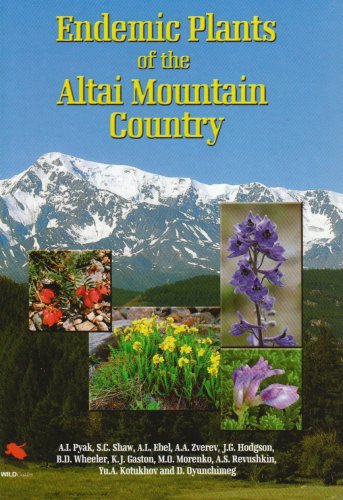Mountain Plants
Category : Soaring Mountains

Endemic Plants of the Altai Mountain Country (WILDGuides)
Mountain plants have to face the most bewildering contrasts in living conditions of any plants found on Earth. These conditions are unbelievably harsh and impose great challenges to survival in the face of very high winds, extreme cold, wildly fluctuating temperatures, thin rocky soils, snow and ice, and a thin atmosphere that contains very little oxygen but huge amounts of UV radiation.
Because mountain plants grow so slowly, most cannot sprout, mature and produce their own seeds in a single season. For this reason most are perennials, which means that they live for many years, as does a tree, for example. These plants use most of their energy just for survival, and that’s why it can take many years for them to put back enough energy to flower and produce seeds.
Due to the high winds and heavy snows on tall mountains, most mountain plants are very supple and have the ability to bend a lot before breaking, and any woody plants are stubby and low .
A lot of the high altitude plants have the ability to retain the heat of the intense sun to use throughout the frosty night. One great example is the snow willow. The buds of this plant are covered in a thick fuzz of tiny white hairs but the bud itself is black. The sun heats up the black core and the heat is trapped there by the translucent hairs, just like a miniature greenhouse.
Mountain soils are usually shallow at higher altitudes, partly because the soil has been scraped off by the ice caps that formed on most high mountains throughout the world during the last glacial interval that ended about 10,000 years ago.
Soils are generally poor in nutrients important to plants, especially nitrogen. Rapid erosion of loose materials is also common and is exacerbated by frost heaving, steep slopes, and, in temperate regions, substantial runoff of meltwater in spring.
Soil is virtually absent on rocky peaks and ridges. However, because of the cool, wet climate, many mountain areas accumulate peat, which creates local deep, wet, acidic soils. In volcanic regions tephra (erupted ash) may also contribute to soil depth and fertility.
The growth of vegetation depends on rainfall and temperature.The vegetation on the lower slopes largely depends on which climate zone the mountain is in. The foothills may be covered in broadleaved forests. These change to needleleaf trees (coniferous trees) like spruce and pines at on the upper slopes (higher altitudes).
As you climb higher up a mountain it gets colder and the trees eventually thin out and disappear. When it gets too cold for trees to grow, it is called a timberline.
The highest parts of the mountain support only sparse grasses and low-growing alpine flowers which can withstand the harsh conditions.
If the mountain is high enough even this vegetation disappears and the peak is bare rock and perhaps covered in snow and ice.
Most alpine plants don’t grow very large in response to the limited resources available. A low-growing, compact form also gives the plants some protection from the wind, cold, snow and ice.
Many mountain species are at risk, especially because of climate change, with higher temperatures affecting the immediate environment and therefore forcing the plants to move in search of colder temperatures to ever-higher altitudes…
The edelweiss, alpenrose and gentian are undoubtedly among the best-known Alpine flowers, but are just a drop in the ocean of the 4,500 vascular plant species found in the Alps – that’s 39% of all European plant species.
Of these 4,500 plant species, 350 are classified as native to the Alps or certain Alpine regions and are often found at high altitude. These native plants include the Zois’ bellflower (Campanula zoysii), round-leaved St. John’s wort and the carniolan lily to name but a few.
Around 900 different plant communities have been surveyed in the Alps and approximately 13,000 plant species, including:
1.Over 5,000 fungi
2. 4,500 vascular plant species
3.Around 2,500 lichens
4.Around 800 mosses
5.Around 300 eupatoriae species (e.g. hemp agrimony, boneset, snakeroot)
If you have any information,questions, or feedback you would like to include in this post.
Please email momo19@naturekingdoms.com or leave your comments below.